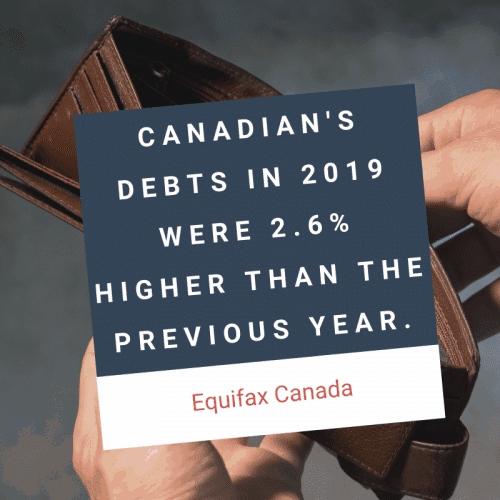Debt can be crippling. It affects individuals regardless of gender, age, employment status or family size. It affects people around the world, including here in Canada.
Smarter Loans Inc. is not a lender. Smarter.loans is an independent comparison website that provides information on lending and financial companies in Canada. We work hard to give you the information you need to make smarter decisions about a financial company or product that you might be considering. We may receive compensation from companies that we work with for placement of their products or services on our site. While compensation arrangements may affect the order, position or placement of products & companies listed on our website, it does not influence our evaluation of those products. Please do not interpret the order in which products appear on Smarter Loans as an endorsement or recommendation from us. Our website does not feature every loan provider or financial product available in Canada. We try our best to bring you up-to-date, educational information to help you decide the best solution for your individual situation. The information and tools that we provide are free to you and should merely be used as guidance. You should always review the terms, fees, and conditions for any loan or financial product that you are considering.

Debt can be crippling. It affects individuals regardless of gender, age, employment status or family size. It affects people around the world, including here in Canada.
Insolvency is increasingly becoming a present issue for more and more Canadians. (Insolvency is literally an inability to pay debts and it’s a hot-button topic as 2020 begins.)
According to the MNP Consumer Debt Index and a new report issued this January, nearly half of all Canadians are approximately $200 away from not being able to pay their bills with another 50% reporting fear of debt as they attempt to pay these lingering expenses.
The holiday season often compounds debts as work hours vary and gift buying takes precedence over bill paying. In mid-2019, Equifax Canada reported on debts faced by Canadians, including a seasonal peak of almost 34% moving toward the summertime months. Equifax noted a total consumer debt in mortgages alone for just the first quarter of the year at $1.907 trillion – an average of $71,300 per person.

Although Statistics Canada noted that the debt-to-income ratio was improving around summertime 2019 – with income growing faster than debt – insolvencies continue to rise in the nation. Debt relief experts Hoyes, Michaelos & Associates Inc. shared details about a consistent uptick in insolvency filings since April 2018. The business mentions that inflating expenses such as food, rent and other household bills is partially to blame as this inflation outpaces wages across the country.
Perhaps you are sick of being burdened by credit card balances. Maybe everyday expenses have become overwhelming. Students loans could possibly be getting the best of you. Or you are just sick and tired of living paycheck to paycheck to paycheck. Whatever your reason, debt repayment is possible even if challenging. It also is quite rewarding. With debts increasing every day and Canadians everywhere facing this problem, we’re here to provide some insightful information for getting out of debt smoothly, swiftly and safely.

Check out these steps for getting yourself out of debt as soon as possible!
It seems simple enough, but ceasing spending can be difficult. Make it a bit easier by limiting your credit card use or sticking to just one. The more that they linger, the more likely you are to spend and dive farther into debt. Also take steps toward removing the temptation:
They say “out of sight, out of mind,” and that works wonders as the first step to tackling debts.
Everyone is guilty of holding onto belongings for longer than necessary. Destash to earn cash! Rummage through your clothes and closets to discover hidden gold among attire, electronics, furniture and more. Sell those extra items that are busy collecting dust then put those dollars toward your debts.

Review your income versus your expenses and create a comprehensive budget that best accounts for your earned dollars. To truly pay debt in a timely manner, you’ll need to cut these expenses as much as possible and budgeting is the best initial step. And the more you can trim those expenses and live as minimalistically as possible, the faster you can become debt-free.
Crafting a workable budget isn’t always simple. The internet is brimming with tools for budget assistance, including free apps downloadable to your phone or device. Some suggestions include Mint, PocketGuard, Goodbudget and Wally, all of which can assist in free budget creation in addition to other features such as bill reminders, low fund account warnings, credit score monitoring and spending tracking. A helping hand is easily and freely available, and it’s highly recommended when trying to stay on top of debt repayment and reduction.
It never hurts to ask for help, including asking debtors for better rates. Many creditors will happily assist if that means you return to on-time and adequate payments – particularly if you’ve fallen behind in recent months. Approach creditors with knowledge and optimism. There’s little harm in making these requests and it could prove financially beneficial to do so.
Even with renegotiation, some creditors remain less than ideal – whether that’s due to lingering high interest rates, long payment terms or other pitfalls. Research your options for credit cards and loans as you consider transferring your balances to more reasonable creditors.
But better terms and conditions may be available, including 0% APR for an introductory time. Transfers can truly help those debts diminish thanks to a little education and effort.
Only paying the minimum dollar amount due every single month will allow the debt to linger longer and longer. Rather than reducing your principal, this ensures you repeatedly pay interest directly to the debtor. Avoid this lengthy cycle by paying more than the minimum payment. The more that you pay directly to the principal balance, the swifter it decreases toward disappearance.